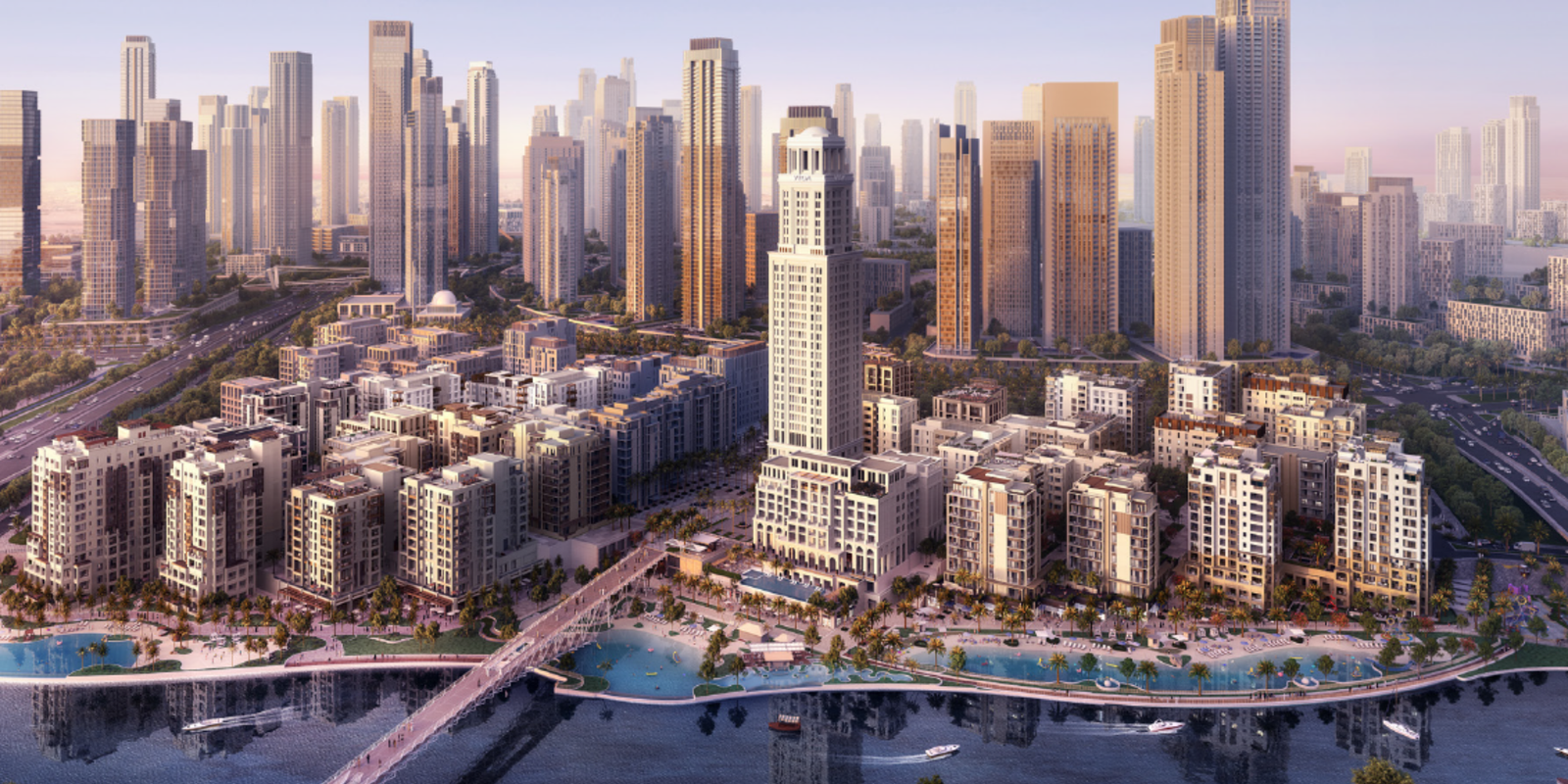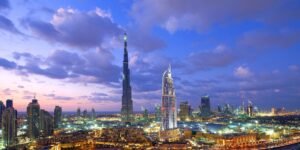Understanding Dubai property market cycles — what 15 years of data tell us
Over the last decade and a half, the Dubai property market cycles have followed a clear rhythm: surge, cool-off, recovery — repeat. Prices rise, the market pauses or corrects, then buyers return and the next leg begins. By studying 2008, 2014 and 2020, you can see the pattern — and use it to make steadier, smarter decisions. As we look to 2025–2026, the same rhythm appears to be setting up again.
The three major cycles you need to know
1) 2008 — The crash
During the global financial crisis, Palm Jumeirah villas fell by roughly 60%, while Dubai Marina apartments dropped around 55%. Investors who bought at the bottom later saw outsized gains as prices recovered.
2) 2014 — The correction
By 2014 the market had overheated again. Jumeirah Park villas fell ~27%, while beachfront homes corrected by 30–40%. It reset pricing and set up the next rally.
3) 2020 — The dip
The pandemic triggered a short 10–15% pullback, but the recovery was rapid — roughly 18 months. The window was brief, which is why many missed it.
What makes 2025–2026 different
Rapid price gains since 2022
Prices have climbed strongly since 2022, and major analysts now expect a moderate 10–15% cooling into late-2025/2026 after a big run-up — a “soft landing,” not a 2008-style crash. [cbre.ae]
A heavy supply pipeline
Independent consultancies flag a large wave of new homes: ~73,000 units in 2025 and a broader pipeline approaching ~300,000 by 2028. Delivery volumes and absorption are the key swing factors to watch.
Demand and population growth
Dubai’s resident base has already passed 4 million and is widely expected to push higher toward the end of the decade, supporting long-term housing need even as near-term supply bulges.
Bottom line for this cycle: strong fundamentals (population, wealth inflows, infrastructure) meet heavy scheduled completions. That is exactly when the market usually pauses, re-prices a little, and then rotates to the next phase.
Area-by-area: how cycles show up on the ground
Villas and established luxury
Prime villa communities tend to be more resilient in downturns and recover faster, thanks to scarce land and deep end-user demand. 2025 data shows villas remain standout performers in this cycle.
Waterfront apartments
Beachfront and island stock is desirable but more cycle-sensitive. In past pauses these areas moved first and furthest before stabilising.
High-density urban zones
Dense apartment districts often show early signs of cooling during oversupply phases and then lead early recovery once absorption improves. Market reviews keep pointing to deliveries and absorption as the main drivers.
The hidden pattern most investors overlook
- Lead–lag behaviour
Apartments in dense or newly released areas often peak and correct first; villas and blue-chip areas tend to lag. If you only watch “citywide averages,” you’ll miss the early turn. - Supply often marks the peak
In each cycle, a flood of launches or handovers has coincided with a top. The 2025–2026 delivery slate is the current red flag to track. - Cycle lengths repeat
Historically, Dubai’s mid-cycle pauses run ~12–24 months; recoveries can span 2–4 years. That cadence fits a soft correction view for late-2025/2026.
What the data and experts say (quick citations)
- CBRE, Q1-2025: UAE market remains resilient; the outlook hinges on supply, costs and sub-market differences. [cbre.ae+1]
- Cavendish Maxwell, Q1-2025: ~73k units projected in 2025; a broader ~300k pipeline through 2028; absorption is key. [cavendishmaxwell.com]
- Knight Frank, Q1-2025: citywide prices at a new high vs 2014; villas the standout segment. [Knight Frank AE]

2026 Dubai regions with strong investment value (by real drivers)
Below are Dubai regions that, based on current trends in the economy, technology, real estate and emerging industries, show a promising setup into 2026 — and why they’re worth a close look.
1) Dubai South & Expo City — aviation, logistics and “new city” growth
- Why it matters: The Al Maktoum International (DWC) expansion (approx. US$35bn) is underway, with plans to become the world’s largest airport and to shift operations over the next decade. Airport-anchored cities pull jobs, logistics and hospitality — then housing follows.
- What to watch: phasing of terminals and runways; airline moves; demand for staff and supplier bases; Expo City’s free-zone business growth.
- Investment angle: early positioning in quality residential near job nodes; income assets tied to aviation, logistics and business services.
2) Dubai Creek Harbour (DCH) — core waterfront + future metro connectivity
- Why it matters: A major waterfront CBD with planned Blue Line metro stations (Creek/Harbour/Festival City), improving connectivity to employment hubs.
- What to watch: Blue Line build progress; retail and public-realm milestones; handover pace vs demand.
- Investment angle: long-term capital growth as access improves; consider mix of 1–2 bed apartments for rental depth.
3) Palm Jebel Ali corridor — next-gen coastline + West Dubai jobs
- Why it matters: Palm Jebel Ali has been relaunched as part of the city’s westward growth strategy, aligned with Dubai 2040 and the D33 agenda. It extends Dubai’s premium shoreline and sits near upcoming logistics/industrial growth. [Arabian Business]
- What to watch: phasing of villa fronts, bridges and utilities; delivery timelines; commuter links back to the core.
- Investment angle: long-duration, premium-led play; early-phase entrants typically benefit most from infrastructure catch-up.
4) Dubai Hills Estate & wider MBR City — family demand and schooling clusters
- Why it matters: Strong end-user pull (schools, parks, healthcare, malls) and a track record of steady take-up. 2025 data shows villas and quality townhouses continue to lead. [Knight Frank AE]
- What to watch: remaining land releases; service-charge discipline; rental yields on mid-sized family homes.
- Investment angle: defensive core holdings with stable occupancy; good balance of yield and long-term appreciation.
5) The Oasis by Emaar — Dubai’s New Luxury Landmark
- Why it matters: Developed by Emaar, The Oasis represents one of Dubai’s most ambitious residential communities — a US$20 billion master plan of ultra-luxury villas, crystal lagoons, and landscaped boulevards. Located between Dubai Hills and Dubailand, it reflects the city’s westward expansion and growing appetite for resort-style suburban living.
- Investment view: Combines brand trust with capital growth. Early investors gain access to Emaar’s flexible payment structures, high liquidity, and the prestige of a gated low-density community.
- What to watch: Phase-one villa completions, lagoon openings, and road connectivity to Sheikh Zayed Bin Hamdan and Al Khail Road.
6) Academic City – International City – Silicon Oasis axis — Blue Line unlock
- Why it matters: The Dubai Metro Blue Line (under construction) links Academic City, Silicon Oasis, International City and Dubai Creek Harbour, creating a new east-west spine. Transit access typically lifts both rents and resale depth over time.
- What to watch: station timelines and last-mile improvements; student and tech-park demand.
- Investment angle: value-led apartments close to stations; rental demand from students and tech workers.
How to use this section: shortlist 2–3 regions that match your goals (yield vs growth), then track quarterly data on handovers, vacancy, and achieved rents. CBRE, Knight Frank and Cavendish Maxwell publish regular updates you can benchmark against.
Your 2025–2026 playbook (simple and practical)
If you’re yield-led: focus on established rental pockets with proven occupancy; monitor vacancy and incentives each quarter
- If you’re quality-led: use any 10–15% pause to accumulate blue-chip villas or prime waterfront stock; scarcity tends to reassert in the next leg.
- If you’re growth-led: follow infrastructure — Blue Line and airport-led expansion are the clearest catalysts into 2026 and beyond.
- Balance the basket: pair a stable, family-led villa/townhouse asset with a selective higher-beta apartment in a transit-benefiting area.
Risks to watch
- Delivery risk: delays can soften near-term corrections and push supply into later years.
- Macro shocks: rates and global growth matter for sentiment and finance costs.
- Segment divergence: apartments vs. villas may not move together; don’t rely on citywide averages.
- Policy changes: lending, visas or fees can shift demand pockets.
Final thoughts — timing your next move
The Dubai property market cycles always repeat. After two years of rapid growth, a moderate correction is likely toward late 2025 and early 2026 — but that very phase can become the best time to buy before the next growth wave begins.
If you want to know which Dubai region holds the strongest investment potential in 2026 — and when the right time to enter the market is — get in touch with us.
Through data-driven analysis, we’ll identify the ideal location that fits your goals — whether you’re focused on rental yield or long-term capital growth.
Contact us today for a free consultation — and let the market cycle work in your favour.





